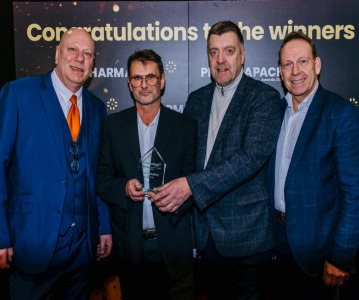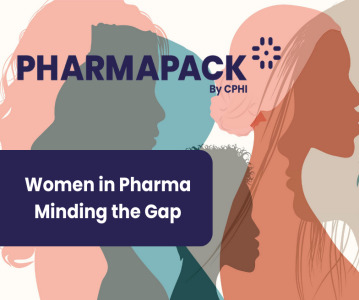Unpacking what we learned: Key Pharmapack takeaways with L.E.K. Consulting
.png)
After another successful Pharmapack show, we sat down with Karin von Kienlin, Senior Partner at L.E.K. Consulting, to discuss the biggest takeaways and surprises from 2 days of intense discussion and collaboration.
What were some of your key takeaways from this year’s Pharmapack show?
Our key takeaways from Pharmapack:
-
Overall extreme volatility of demand and supply over the past 18 months as well as supply chain issues, inflation, interest rate increases, and cost drivers (energy prices, etc.) have had an impact on the majority of the participants and there was much note comparing likely short- and medium-term outlooks. Our newly released European Brand Owner survey, in which we asked 600 brand owners across Pharma, OTC, Healthcare, and other end-markets in the EU and Poland about their outlook, recognised the volatility of the past 18 months but shows cautious optimism around demand recovery and cost pass-through.
-
Although sustainability still plays an important long-term role, the pressures listed above along with regulatory softening around timelines of implementation for the introduction of recyclable packaging, for instance, have meant that many alternative materials projects have been put on the back burner while CO2 footprint reduction was a greater focus in pharma organisations. These sentiments are supported by the results of the Brand Owner Survey, which for the first time in 3 years saw sustainability drop from one of the two top priorities to a rank of six (out of nine).
-
Still, there is broad agreement that the need for increased sustainability is not going away and that, in light of long development cycles, action must be taken. For this to happen, the regulator needs to create the appropriate incentives and pressures. The industry will benefit from collaborating with the regulator to define the most effective and efficient framework. It is also worth noting that many chemical companies and distributors are increasingly attracted by the prospect of growth in sustainable materials and are exploring their opportunities in the space.
-
Many pharma packaging companies are expanding their horizon to broaden their range of services to pharma companies and CDMOs/CMOs for mutual benefit. There is plenty of opportunity to seek out new collaboration models within an ecosystem of more complex packaging formats. In particular, larger players are creating network of collaborations on specific topics to synergise their capabilities on specific projects. Aggregation and integration are focused on expanding services across the value chain or acquiring very specific industrial capabilities.
-
For players focused on injectables, the rise of GLP-1 inhibitors is viewed as an opportunity as well as a challenge that will need industry-wide solutions, with a potential to be as impactful and disruptive as the COVID-19 pandemic in terms of pressure on industry capacity and pressure to find solutions that work for all stakeholders (pharma companies, regulators, caregivers, patients). Main concerns are around the “right” delivery platform, production capacity, and waste management.
You participated in the panel discussion on contract pharmaceutical packaging. What opportunities are there for contract packaging organisations in today’s pharmaceutical landscape and where do you think it will go in the future?
There are a lot of opportunities we see around three main vectors of growth:
-
Optimising the manufacturing process by addressing new needs of customers or addressing existing needs of customers better. This may have to do with downgauging of materials for improved cost and sustainability propositions, or changing out specific materials upon client’s requests (such as PVC) as examples.
-
Growth along the pharma value manufacturing chain, for instance adding steps previously not covered such as project management of several component suppliers into a unified product (in more complex packaging/device formats), form fill, and seal activities or inspection services.
-
Offering of adjacent services within the same pharma value chain, such as small batch production, digital health applications, or smart packaging features. As patient and caregivers’ needs evolve, medical and packaging technology develops and regulations change, there is always runway to continuously improve and develop one’s offering. In particular, the increased interest of pharma companies in outsourcing non-core parts of their value chain such as manufacturing and packaging to contract manufacturing and packaging companies continues to produce many opportunities.
The sustainability track was one of our most attended conference tracks at this year’s Pharmapack show. How do you think shows like Pharmapack are championing sustainability efforts in the pharmaceutical packaging sector? How can we as a collaborative industry do more?
While sustainability was not as hot a topic on this year's show as in prior shows given the current economic and regulatory environment, it is clear that the whole industry will have to makes moves to become greener in the long term, and the leading players are continuing to work on their proposition. Compared to consumer packaging waste, pharma only accounts for about 10% of the volumes; in addition, many pharma products must be packaged in multilayer formats for their barrier properties, which are fossil-based and impossible to recycle. This in addition to the economic pressures European industry is facing in light of the many global crises have led to less regulatory pressure towards more sustainable packaging; pharma companies’ focus appears to have shifted somewhat away from packaging material initiatives and towards CO2 reduction in pharma production.
Still, while total pharma waste volumes are a small share of overall waste, the amount is significant and growing, and will at some point come under renewed scrutiny. The regulator plays a key role in levelling the playing field and increasing the requirements for all players. Therefore, industry-wide events can contribute to finding the solutions of the future by offering the regulator a role and providing a forum for industry participants to discuss with the regulator. In addition, these industry events can inspire by showcasing innovative and sustainable solutions developed by packaging companies and adopted by more sustainability-minded pharma companies ahead of time.
A potential angle that was discussed in the CPO panel is to focus on a set of high-value products, either from a therapeutic area angle or a platform angle (e.g., injectables), where regulators and pharma companies are less price sensitives and more likely to accept higher costs connected with ESG initiatives. This could create an environment in which high-cost products “pay the price” to allow CPOs to implement broader changes towards more sustainable packaging.
Which conference tracks stood out to you the most? Which discussions were the most surprising to you?
The contract packaging panel along with the sustainability roundtable hit on very interesting trends and issues. As compared to other industries, there is a clear desire from key CPO players to collaborate on industry-wide issues, and a sense of the limits to which each CPO can shape the market. In this case, the pressures on the CPO industry resulting from capacity constraints, demand volatility, supply chain issues, complexity of new product demands, regulatory, and sustainability pressures surprisingly foster collaboration rather than competition or island solutions.
Another surprising element was the focus on regional vs global views of the world. The pandemic and the supply chain disruptions of the past couple of years have underlined the importance of security of supply. It appears that the industry is at a crossroads in that regard and attention is moving away from a global perspective with more focus on regional dynamics.
What do you hope the pharmaceutical packaging and drug delivery industry will discuss more in future conferences?
The topic of collaboration will remain critical in the future to face industry-wide challenges, and there is a need for more in-depth discussion between “material” focused CPOs (e.g., PET, glass, etc,) and “technology” focused CPOs (e.g., injectors, wearables, etc.) in finding innovative solutions to meet demands from pharma for more sustainable solutions.
More discussions on the future of logistics will be important, to cover both procurement of raw materials and distribution of the finished product. The future of global vs regional supply chains will also be a contentious topic in the future, where cost and efficiency arguments need to be evaluated in the light of security of supply.
Related News
-
News Key takeaways from Saudi Arabia's National Biotechnology Strategy
In January 2024, Saudi Arabia released its National Biotech Strategy, an ambitious plan to localise biomanufacturing, incentivise R&D and establish the Kingdom as the regional biotech leader by 2030, and an internationally recognised hub by 2040. -
News Pharmapack Awards 2024 Packaging Innovation Award Winner – Nissha Europe GmbH
The 2024 Pharmapack Awards celebrated the best in innovation and design for the pharmaceutical packaging and drug delivery industyr on January 24, 2024. -
News What did we learn from Pharmapack 2024? The green edition
Pharmapack Europe, held in Paris each year is a great opportunity to see the latest innovations and trends in pharmaceutical packaging and to hear from the companies and experts in the area on what aspects are most important to them in their products a... -
News Pharmapack Awards 2024 Start-up Innovation Award Winner – Capa Valve Ltd
The 2024 Pharmapack Awards celebrated the best in innovation and design for the pharmaceutical packaging and drug delivery industry on January 24, 2024. -
News Pharmapack Awards 2024 Patient-Centric Design Award Winner – Dr Ferrer BioPharma
The 2024 Pharmapack Awards celebrated the best in innovation and design for the pharmaceutical packaging and drug delivery industry on January 24, 2024. -
News Women in Pharma: Minding the Gap at Pharmapack 2024
2024 marks the first year Pharmapack will host a Diversity track dedicated to bridging the gap within the pharmaceutical packaging and drug delivery sector. The track includes a panel discussion on 'Enabling Diversity in the Workplace,' focused... -
News Pharmapack Awards 2024 - Celebrating Packaging and Drug Delivery Innovation
The 2024 Pharmapack Innovation Awards ceremony celebrated the best in pharmaceutical packaging and drug delivery innovation at all levels. The awards were held on January 24, 2024 at the Paris Expo Porte de Versailles. -
News Pharmapack 2024 - From the Floor
Paris once again welcomes Europe’s leading trade show in pharmaceutical packaging and drug delivery innovation. Join our content team as Pharmapack 2024 opens its doors to leading experts and innovators in pharmaceutical packaging and drug delive...
Position your company at the heart of the global Pharma industry with a CPHI Online membership
-
Your products and solutions visible to thousands of visitors within the largest Pharma marketplace
-
Generate high-quality, engaged leads for your business, all year round
-
Promote your business as the industry’s thought-leader by hosting your reports, brochures and videos within your profile
-
Your company’s profile boosted at all participating CPHI events
-
An easy-to-use platform with a detailed dashboard showing your leads and performance

.png)




.png)
